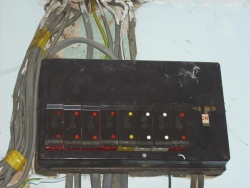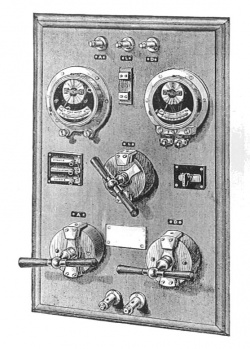Difference between revisions of "CU"
Jump to navigation
Jump to search
(→Brands: remove duplicated section) |
(pic) |
||
| (7 intermediate revisions by 2 users not shown) | |||
| Line 1: | Line 1: | ||
| − | + | [[image:Fusebox 195-4.jpg|250px|right]] | |
| + | [[image:Main_switchboard,_c._1888_(Forty_Years_of_Electrical_Progress).jpg|250px|right]] | ||
| − | + | This article is a starting point for the various articles that deal with Consumer Units (or Fuseboxes as they used to be known). | |
| − | + | ||
| − | + | The pictures on the right show 100 years of progress, from 1888 to 1988. | |
| + | |||
| + | Related Topics: | ||
* [[House Wiring for Beginners]] | * [[House Wiring for Beginners]] | ||
* [[Rewiring Tips]] | * [[Rewiring Tips]] | ||
| + | * [[Electrical Installation]] | ||
| − | + | Consumer unit articles: | |
| − | + | * [[Consumer Units]] | |
| − | + | * [[MCB]] | |
| − | + | * [[Fuse]] | |
| − | + | * [[RCD]] | |
| − | + | * [[Changing a consumer unit]] | |
| − | |||
| − | |||
| − | |||
| − | |||
| − | |||
| − | |||
| − | |||
| − | |||
| − | * | ||
| − | |||
| − | |||
| − | |||
| − | |||
| − | |||
| − | * | ||
| − | |||
| − | |||
| − | |||
| − | |||
| − | |||
| − | |||
| − | |||
| − | |||
| − | |||
| − | |||
| − | |||
| − | |||
| − | |||
| − | |||
| − | |||
| − | |||
| − | |||
| − | |||
| − | |||
| − | |||
| − | |||
| − | |||
| − | * | ||
| − | |||
| − | |||
| − | |||
| − | |||
| − | |||
| − | |||
| − | |||
| − | |||
| − | |||
| − | |||
| − | |||
| − | |||
| − | |||
| − | |||
| − | |||
| − | |||
| − | |||
| − | * | ||
| − | * [[ | ||
| − | |||
| − | |||
| − | |||
| − | |||
==See Also== | ==See Also== | ||
| − | |||
| − | |||
* [[:Category:Electrical|Electrical articles]] | * [[:Category:Electrical|Electrical articles]] | ||
* [[Special:Allpages|Wiki Contents]] | * [[Special:Allpages|Wiki Contents]] | ||
* [[Special:Categories|Wiki Subject Categories]] | * [[Special:Categories|Wiki Subject Categories]] | ||
| + | * [http://www.flameport.com/electric/old_equipment/wylex_standard_brown_wooden.cs4 Wylex CUs pictured above] | ||
[[Category:Electrical]] | [[Category:Electrical]] | ||
Latest revision as of 13:58, 10 April 2011
This article is a starting point for the various articles that deal with Consumer Units (or Fuseboxes as they used to be known).
The pictures on the right show 100 years of progress, from 1888 to 1988.
Related Topics:
Consumer unit articles:

